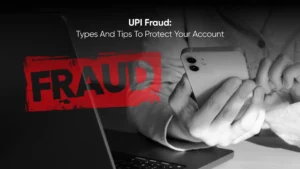“Digital arrest” is a cyber scam where crooks pretend to be police, CBI/ED, TRAI, or bank officials on phone or video calls. They accuse you of a fake crime (like money laundering or SIM misuse), flash forged IDs or “warrants,” and threaten arrest, account freeze, or media exposure unless you follow their orders. The goal is simple: scare you into sending money or sharing sensitive info.
In India, agencies have issued repeated warnings about this trend and urge people to verify independently and report such calls to the national cyber helpline 1930 or cybercrime.gov.in. There’s no such thing as a real “digital arrest.” Genuine law enforcement will not threaten you on a call or demand payments via UPI/wallets.
Table of Contents
ToggleHow Does the Digital Arrest Scam Work?
Digital arrest scams follow a clear pattern. Scammers use fear, fake authority, and pressure to trap victims. Here’s how they usually play out.
- Initial contact: You get a call/SMS/WhatsApp saying your Aadhaar, SIM, bank account, or parcel is linked to a crime. The caller claims to be from the police, TRAI, CBI, ED, or a bank.
- Authority play: They share fake badge numbers, “case IDs,” or send PDFs with official-looking logos to appear legitimate.
- Switch to video call: They move you to a video platform (often Teams/WhatsApp), wear uniforms, show forged seals, and keep you on camera for hours and call it a “digital arrest.”
- Threats & isolation: They warn you not to contact anyone, claim calls are “recorded,” and threaten jail, travel bans, or asset freezes.
- Payment demand: You’re told to transfer money “for verification/bail/CBI supervision account,” or to “prove funds are clean.” Sometimes they ask for your OTPs or remote-access apps.
- Money laundering: Funds are routed through mules/hawala or offshore accounts; SIMs and accounts used may be quickly recycled.
Common Tactics Used by Scammers
- Fake IDs, warrants, and letterheads (CBI/ED/courts/police).
- Intimidation via video calls in uniforms; 24×7 “monitoring.”
- Urgent threats: “Don’t cut the call,” “We’ll freeze your accounts,” “You’ll be in the news.”
- SIM/number misuse claims; pressure to share OTPs or install apps.
- Sharing bogus case files and asking money for “verification” or “clearance.”
- Using mule bank accounts, crypto/USDT routes, and quick withdrawals.
Also Read: What is Fake loan: Tips to Identify and Avoid while Availing the Loan?
Real-Life Digital Arrest Fraud Cases in India
- Delhi (July 2025): Two women were held on a long video call by men posing as police and coerced under threats, an example of how victims are isolated and intimidated.
- Nationwide advisories (2024–2025): The Enforcement Directorate flagged cases where victims were forced to transfer money to “fund regularisation” or “CBI supervision” accounts; I4C/PIB reported large-scale takedowns of WhatsApp/Skype IDs used in such scams.
- Noida (2025): A gang ran a fake “International Police & Crime Investigation Bureau,” staging video calls with forged seals and pushing payments to a sham “CBI supervision account.” Arrests followed.
How to Identify a Digital Arrest Scam
- Out-of-the-blue threats: Unexpected calls accusing you of crimes, demanding you stay on the line.
- Urgent payment requests: Money for “bail,” “verification,” or “unfreezing accounts.” Real agencies never collect money over calls.
- Unofficial numbers/handles: Mobile/WhatsApp numbers, free email IDs, or links to non-govt forms.
- Pressure to keep secrets: “Don’t tell family/HR/lawyer,” “We’re recording this,” “Your phone is seized.”
- Fake documents & uniforms: Poor grammar, mismatched logos, doctored PDFs, or staged video backdrops.
Also Read: 6 Effective Strategies Against Loan Scams
How to Protect Yourself from Digital Arrest Frauds
- Hang up and verify: Disconnect. Call your local police station or the national helpline 1930, or report at cybercrime.gov.in. Do not call back the numbers they give you.
- Never pay or share OTPs: No authority asks for money, UPI transfers, remote access, or OTPs on calls.
- Check numbers & flag them: Use Sanchar Saathi/Chakshu to report suspicious callers and block misuse.
- Secure your SIM & phone: If your phone is lost/stolen or you suspect SIM swap, block the device/IMEI via Sanchar Saathi (CEIR) and contact your telecom provider.
- Stay informed: Follow advisories from I4C/MHA, TRAI/DoT, and state cyber cells. Share learnings with family, friends and colleagues.
Reporting Digital Arrest Scam in India
If you face or suspect a digital arrest attempt:
- Call: 1930 (National Cybercrime Helpline).
- Report online: cybercrime.gov.in (National Cyber Crime Reporting Portal)
- Telecom actions: Report suspicious numbers via Sanchar Saathi; block a lost/stolen phone’s IMEI using CEIR.
- Keep evidence: Save call logs, screenshots, payment references, and chat IDs.
Also Read: Top 12 Signs of a Fake Loan App in India
Digital Arrest Fraud vs Traditional Cybercrime: What’s Different?
Digital arrest scams rely on fear + impersonation over live calls to force immediate action, whereas many traditional scams lean on links, phishing pages, or silent malware. Knowing this difference helps you respond correctly
Aspect | Digital Arrest Fraud | Traditional Cybercrime (phishing, OTP theft, malware) |
Hook | Threat of arrest/case; fake officials on video/voice calls | Temptation or deception via links, attachments, fake sites |
Pressure | Stay on call, don’t tell anyone, pay now | Click fast, enter OTP/password, download “update” |
Payment | “Bail/verification” transfers to mule accounts | Card/UPI misuse after stealing credentials |
Proof used | Forged IDs, “warrants,” uniforms, seals | Spoofed websites, masked URLs, fake app installs |
Best response | Disconnect → Verify → Report 1930/cybercrime.gov.in | Don’t click → Secure accounts → Report |
Frequently Asked Questions
Is Digital Arrest Legal Under Indian Law?
No. There’s no concept of “digital arrest.” Real police don’t arrest or “detain” you over a phone/video call.
Can Law Enforcement Ask For Money Over Phone Calls?
No. Government agencies never demand payments via UPI/wallets or ask for OTPs or fines/fees, if any. Go through official channels only.
What Should I Do If I Receive A Digital Arrest Scam Call?
Hang up, don’t share details or install any app, and report it to 1930 and cybercrime.gov.in. Inform your bank if you sent any money.
How Can I Verify If A Digital Arrest Warrant Is Genuine?
There’s no “digital warrant.” Call your local police station using numbers from official websites or visit in person. Never trust numbers shared by the caller.
Are Video Call Threats From Scammers Common?
Yes. Scammers often use uniforms, fake IDs, and long video calls to scare you. End the call and report it.
How Quickly Should I Report A Suspected Scam?
Immediately. Faster reporting (minutes, not hours) to 1930 improves the chance of blocking or tracing funds. Also, ensure to save screenshots and call details.









